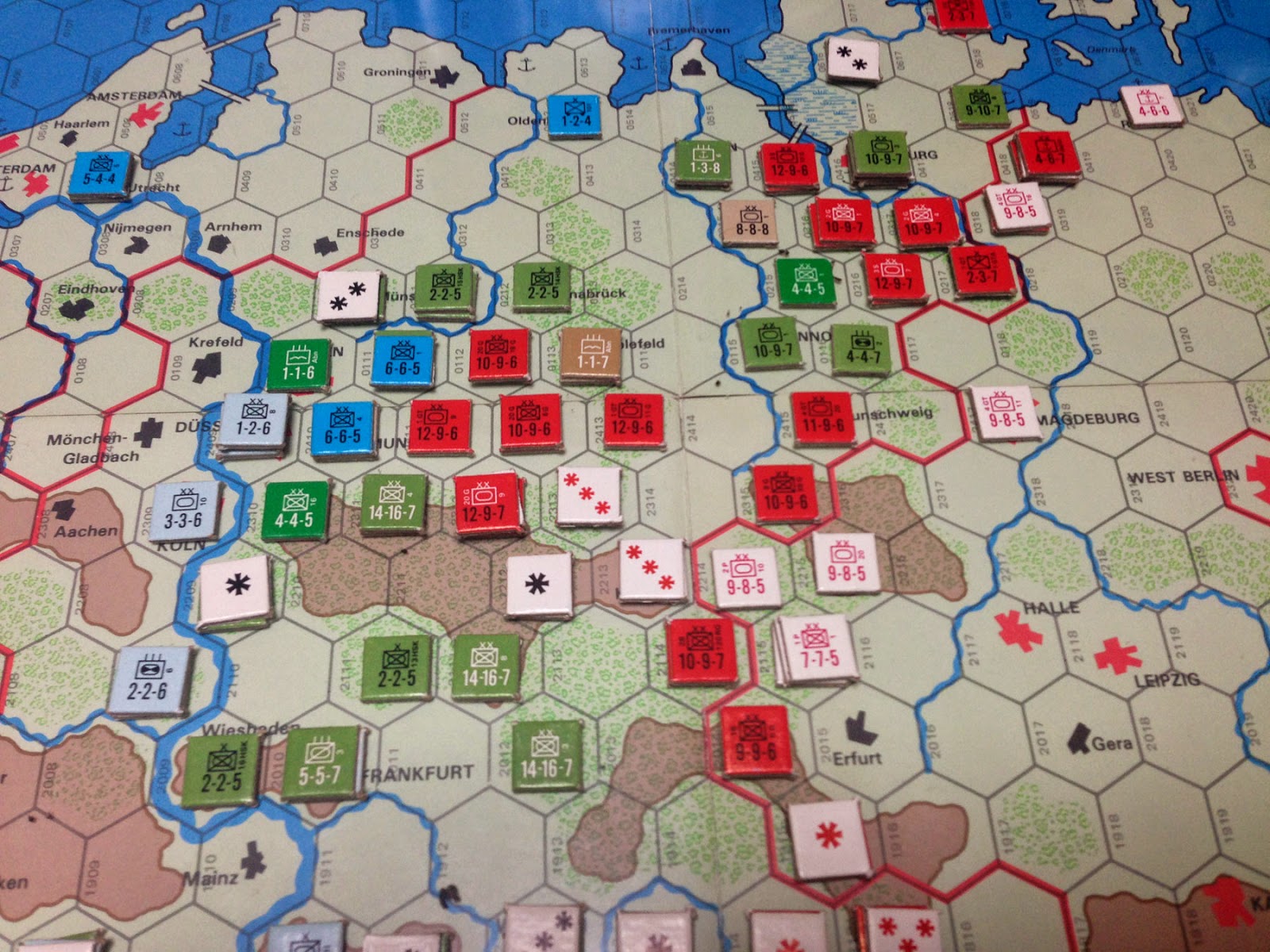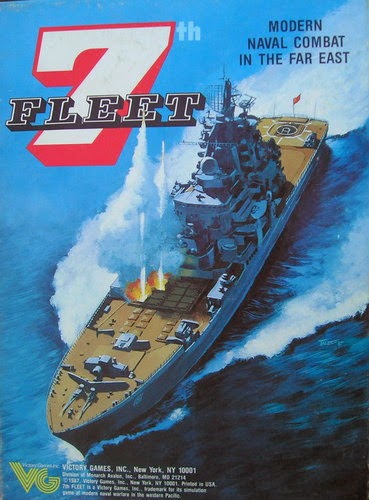The Reds Smash Through
Playing "Third World War: Battle for Germany" again these days after a break from it. I'm really starting to enjoy how simple but elegant the system works and takes into account the different capabilities of both sides. To further explain, the Warsaw Pact gets two movement and combat phases, both with a second echelon phase that allows follow-up units in the rear to take advantage of breakthroughs by first line units by advancing through the breach in the front lines. Thinking more deeply about how to maximize my second echelon units, I managed to get quite a breakthrough happening in turn one as Soviets ended up making their way close to Dortmund. Yikes!
On the other hand, I'm starting to get the hang of NATO defense and counterattack. The Pact player is trying to advance quickly, which means that there are going to be some vulnerabilities in their advance. The NATO player needs to find those weaknesses and hit at them as hard as they can with the American units while using the other smaller and weaker NATO defenders to sit back and try to slow the Pact onslaught.
I've been playing the game all through this week, one or two segments per evening. Finally after finishing turn one, I've tried some different things in this playthrough that have yielded some interesting results. First off, NATO rolled horribly for initial movement. The largest US divisions were stuck twiddling their thumbs way off to the west while the Soviets were poised to enter West Germany without an invitiation.
The Pact predictably won air superiority at the start of the turn and managed to cause some minimal damage to NATO airfields while putting a Canadian unit near the front out of supply (NATO used emergency supplies to reach the Canucks but had to deprive a French division near the France/West German border to do so). NATO played it smart and did not try to contest air superiority for this turn (NATO will almost certainly get it next turn so why worry?). Unfortunately, a number of F-15s were lost intercepting Russian strike missions but they gave as good as they got.
The Soviets used lots of air transport points (something I hadn't done in any previous games to any serious extent) and got several desant and para regiments to take Frankfurt and Mannheim (another airmobile raid on Dusseldorf ended in disaster for the Russians - oh well). This really slowed the rear NATO units from advancing from western Germany and France towards the Fulda Gap. NATO had to spend one valuable turn eliminating these pesky units from their cities before launching a counterattack at the massive Soviet breakthrough in the middle of the board. On the second NATO attack phase, air units played a pivotal role in helping the American and British divisions force a few key Soviet and Polish divisions on a retreat. The tide is hardly stemmed, however, and things look particularly dire for the western forces as they attempt to staunch the bleeding.
Aircraft maintenance phase at the end of the turn was a boon for NATO as every single one of its air units was able to get back in the action for next turn. The Soviets faired poorly, however, as only half the Warsaw Pact air force was able to recover. My prediction is that NATO will be able to use its air power to better effect after gaining air superiority and they may be able to cut off the large Soviet force making its way steadily towards the Rhine.
I have to say that I really admire the way that the game handles aircraft by integrating the factors into ground combat attack odds. It works really well without distracting from the game's main focus while at the same time accounting for how crucial the air war is for both sides. I'm starting to gain an appreciation for why the game is so well-liked by the community. It is indeed a classic in the true sense of the word.
 |
| End of Turn 1: Third World War - The Battle for Germany |
On the other hand, I'm starting to get the hang of NATO defense and counterattack. The Pact player is trying to advance quickly, which means that there are going to be some vulnerabilities in their advance. The NATO player needs to find those weaknesses and hit at them as hard as they can with the American units while using the other smaller and weaker NATO defenders to sit back and try to slow the Pact onslaught.
I've been playing the game all through this week, one or two segments per evening. Finally after finishing turn one, I've tried some different things in this playthrough that have yielded some interesting results. First off, NATO rolled horribly for initial movement. The largest US divisions were stuck twiddling their thumbs way off to the west while the Soviets were poised to enter West Germany without an invitiation.
The Pact predictably won air superiority at the start of the turn and managed to cause some minimal damage to NATO airfields while putting a Canadian unit near the front out of supply (NATO used emergency supplies to reach the Canucks but had to deprive a French division near the France/West German border to do so). NATO played it smart and did not try to contest air superiority for this turn (NATO will almost certainly get it next turn so why worry?). Unfortunately, a number of F-15s were lost intercepting Russian strike missions but they gave as good as they got.
The Soviets used lots of air transport points (something I hadn't done in any previous games to any serious extent) and got several desant and para regiments to take Frankfurt and Mannheim (another airmobile raid on Dusseldorf ended in disaster for the Russians - oh well). This really slowed the rear NATO units from advancing from western Germany and France towards the Fulda Gap. NATO had to spend one valuable turn eliminating these pesky units from their cities before launching a counterattack at the massive Soviet breakthrough in the middle of the board. On the second NATO attack phase, air units played a pivotal role in helping the American and British divisions force a few key Soviet and Polish divisions on a retreat. The tide is hardly stemmed, however, and things look particularly dire for the western forces as they attempt to staunch the bleeding.
Aircraft maintenance phase at the end of the turn was a boon for NATO as every single one of its air units was able to get back in the action for next turn. The Soviets faired poorly, however, as only half the Warsaw Pact air force was able to recover. My prediction is that NATO will be able to use its air power to better effect after gaining air superiority and they may be able to cut off the large Soviet force making its way steadily towards the Rhine.
I have to say that I really admire the way that the game handles aircraft by integrating the factors into ground combat attack odds. It works really well without distracting from the game's main focus while at the same time accounting for how crucial the air war is for both sides. I'm starting to gain an appreciation for why the game is so well-liked by the community. It is indeed a classic in the true sense of the word.


Comments
Post a Comment